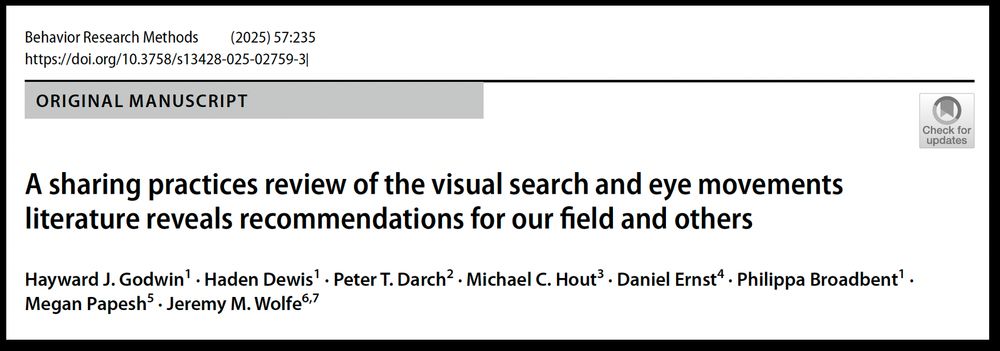
We have a paper out at Behavior Research Methods. Led by Hayward Godwin, it examines sharing practices (using visual search as a case study) and makes recs for sharing data outputs in a manner that will enable others to better find, access, and understand them. link.springer.com/article/10.3...
02.08.2025 19:16 — 👍 8 🔁 1 💬 0 📌 0
Authors on blue sky: @hadendewis.bsky.social, @haywardgodwin.bsky.social, @cherylmetcalf.bsky.social
05.08.2025 14:29 — 👍 1 🔁 1 💬 0 📌 0

🧵5/6
To our surprise, in Experiment 2, participants consistently prioritised interactions with information-poor cubes first.
🔍 Why? We believe that whilst less optimal, it was cognitively easier to process information-poor cubes first.
In other words, effort wins again.
05.08.2025 14:29 — 👍 0 🔁 1 💬 1 📌 0

🧵 4/6
In Experiment 2 we focused on visual information. Cubes either contained multiple shapes (information-rich) or were predominately empty (information-poor).
Our logic? Focusing on areas with a large number of potential targets would be the more optimal strategy.
05.08.2025 14:29 — 👍 0 🔁 1 💬 1 📌 0

🧵 3/6
In Experiment 1, half of the cubes were made to be hard to rotate, and half were easy.
Our results showed that participants developed an extremely strong and consistent bias towards selecting easy cubes first.
😴 We’re wired to avoid physical effort – even in simple mouse movements.
05.08.2025 14:29 — 👍 0 🔁 1 💬 1 📌 0
🧵 2/6
Methods: We ran two experiments where participants rotated virtual cubes whilst trying to find a target T-shape amongst distractor L shapes.
💻 We utilised @threejs.org and @jspsych.org to make this possible. You can demo this yourself via this link! – tinyurl.com/4tz6aufs
05.08.2025 14:29 — 👍 1 🔁 1 💬 1 📌 0
Professor of Health Innovation & Technology at the University of Southampton, UK. Head of School- Healthcare Enterprise & Innovation. Exec Dir. MSc Medical Technology, Innovation & Design. Inventor, innovator, leader and mam of boys.
Research Psychologist: mental health, thought processes & creativity 🩷Science comms & crochet 🧶 PhD, CPsychol,
Not a therapist.
Visuomotor scientist interested in how having hands that can grasp things shapes how we see the world. Also I like to cook.
Please consider visiting & sharing this campaign to help with the medical care costs of my partner Sara: https://gofund.me/03bfd577
SCDTP funded PhD student at University of Portsmouth researching autism, family, and higher education | views mine
🌐 elinorlim.com
In the UK we train educational, clinical and counselling psychologists, while around the world our research is having a direct impact. We attract millions of pounds in funding and offer a stimulating research environment that inspires our students.
Postdoc at University of Manchester | Interested in memory, attention, visual search, eye movements | he/him
Lecturer at University of Southampton. Res: Uncertainty; Anxiety; Emotion; Neurobiology; Translation from lab to clinic. Editoral Board Member at BRAT & INTPSY. Committed to generating impact and championing EDI.
Assistant Research Scientist at the University of Michigan Transportation Research Institute. Attention, Visual Perception, Driver Behavior. https://hanzhang.cv/
Magic Scholar; Cognitive Scientist; Carthage College Psych Science prof; Weird experiences make a life well-lived.
Terrible opinions are my own.
http://anthonybarnhart.com/
Professor of Experimental Psychology @ University of Southampton. Reading Researcher.
Social/personality psychologist, runs a hedgehog rescue and loves martial arts
Associate Dean for Research at NMSU HEST. Associate Editor at AP&P. Former NSF Program Director. Prof of Psychology (and Kinesiology). Director of NMSU Discovery Scholars Program. Director of two research labs. Treasurer of OPAM conference. +Other roles
Associate Professor in Psychology at the University of Southampton, UK. Research is mostly focused on search in all its forms: visual search, interactive search, eye-tracking. More recently I've begun working on some open science projects too.
official Bluesky account (check username👆)
Bugs, feature requests, feedback: support@bsky.app





